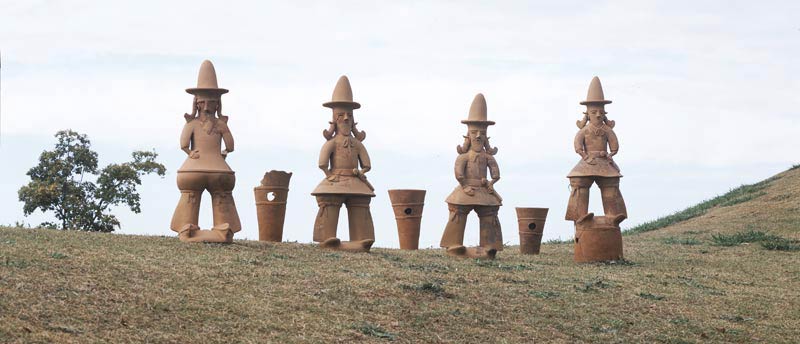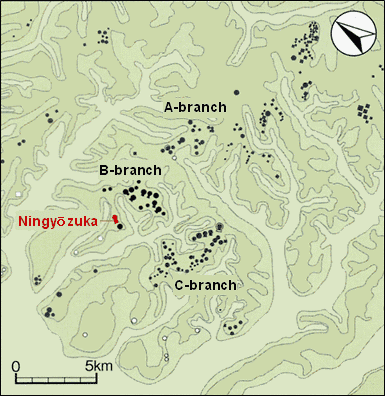Ningyōzuka:
A group of bearded haniwa warriors. The outline of the building plan comes to light beneath the mound.

Bearded haniwa warriors
Warrior haniwa figures with full beards like these are characteristic of the former Sanbu county district facing the Kujūkuri plain in Chiba prefecture. Characteristic motifs such as the broad-brimmed hats and leather boots are also held in common. Previously found clustered at the Tonozuka and Himezuka tombs in the town of Yokoshibahikari, at the Kyōsōzuka tomb in Sanmu and elsewhere, the Ningyōzuka example is the first to be excavated outside the former Sanbu county district. The composition of the representational haniwa group at Ningyōzuka is a condensation of the Sanbu examples in its content, with horses as the only animals and houses as the only utilitarian objects. There is no tradition of placing haniwa on the mound in the Shiinazaki tomb group, and it may be said highly likely that these items were carried from the Pacific side to the Tokyo bay side over a distance of about 30 km. The height of the warrior haniwa in the center is 131.2 cm.

Haniwa lined up on the mound (reconstruction)

|
Exchange in stone materials and haniwa 
Distribution map of the Shiinazaki tomb group |

Map of the mound in its entirety
Beneath the fill used to build up the mound, an outline made with narrow ditches was discovered. These should be regarded as the building plan used in the mound's construction; the center of the uncovered concentric rings lies at the center of the round portion of the mound, the inner circle is nearly congruent with the base of the upper tier of the mound's round portion, and the outer circle is seen to encircle the mound's base. The radius of the inner circle is 7.2 m, that of the outer circle is 12.6 m, and through comparison with the mound's cross section, the inner circle is seen as marking off the area from which fill was first used in building up the round portion of the mound, and the outer circle, as detected at the tomb's constriction, as similarly marking the area from which fill was used for the square portion of the mound.
Ningyōzuka Tomb, Chiba City, Chiba Prefecture
The Oyumi/Shiinazaki tomb group, located on the northeastern shore of Tokyo bay, is a cluster of more than 200 tombs built over a span centering on the latter half of the sixth to the beginning of the seventh centuries. The Ningyōzuka tomb is a keyhole-shaped mound build around the end of the sixth century, in the B-branch subgroup of the Shiinazaki tomb group, the nucleus of the overall cluster.
The length of Ningyōzuka's mound is 42.8 m, largest in the Shiinazaki tomb group, and the mound is surrounded by double rectangular moats.
With a total of seventeen tombs, including keyhole-shaped, scallop shell-shaped, and round mounds, the B-branch is the central subgroup of the Shiinazaki tomb group, and among these Ningyōzuka is the only mound at which representational haniwa in the shapes of men, horses, houses, and so forth, were lined up along with cylindrical haniwa.
Lines of haniwa stood atop the mound and on a terrace at mid-level on the mound; representational haniwa were lined up from the horizontal stone chamber toward the mound's rectangular portion, along the terrace on the southern side of the mound.
Six warrior figurines were lined up facing the horizontal stone chamber and the mound's southern slope, followed by two male figures dressed in round hats, a group of women including miko (shrine maidens) with their hair tied up in topknots, a woman with a vase on her head and a group of small-faced figurines of indeterminate sex, followed by stable boys leading four horses, with another stable boy leading the entire group. As additional human haniwa were recovered, whose original locations are unknown, it is thought that at least twenty-two human figurines once stood in line at the tomb. Also, two house-shaped haniwa were placed at the top of the rectangular portion of the tomb.
Characteristics and derivation of the haniwa
As their characteristics in terms of shape as well as traces (brush-like markings) left by tools used in their manufacture are very similar to haniwa of the former Sambu county district on the Pacific coast side of the prefecture, it is clear that the same line of haniwa craftsmen were involved in the production of both the cylindrical and representational haniwa of Ningyōzuka.
In addition, the shape of the mound and the presence of rectangular-shaped moats are points in common with the Tonozuka tomb in the town of Yokoshibahikari, and the use of soft sandstone for the horizontal stone chamber in combination with schist from the Tsukuba region for the sarcophagus is the same as at the Kyōsōzuka tomb in the city of Sanmu and elsewhere. From this it is understood that in the Kanto region during the latter half of the sixth century, stone materials and haniwa were actively carried from distant locations, and through these materials chiefs in various districts engaged in lively exchanges. (Shirai Kumiko)
